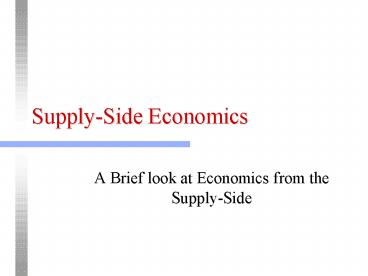Supply-Side Economics PowerPoint PPT Presentation
1 / 16
Title: Supply-Side Economics
1
Supply-Side Economics
- A Brief look at Economics from the Supply-Side
2
Supply-side History
- François Quesnay and the physiocrats
- Around the year 1750.
- Emphasized the importance of property rights in a
market economy - Argued that excessive taxation diminishes output
- Argued that high tax rates
- Kill growth.
- May diminish tax receipts, whereas lowering tax
rates may result in such rapid growth as to
increase tax receipts.
3
History, continued
- Adam Smith in the Wealth of Nations (1776) writes
that taxes reduce the incentive to work and firms
to employ. - Jean Baptiste Say (1821) argued
- high taxes impoverish the individual without
enriching the state, and - high taxes are economic suicide.
- Karl Marx in Das Kapital (1867) writes
- Over-taxation is a principle in Europe
4
Redistribution
- Keynes claimed Malthus (ca. 1820) as his logical
predecessor. Malthus feared short-run inadequate
demand as a result of over-saving - Profits go to owners of capital (capitalists).
- The capitalists are rich, therefore tend to save
(I.e., they have a lot of discretionary income). - As a larger and larger portion of income goes to
the capitalists, consumption falls. - Deficient demand results, leading to widespread
unemployment. - Solution redistribute income from the rich to
the poor.
5
Mundell
- Robert Mundell created modern supply-side
economics in a single knock-out paragraph at the
end of a monograph published in 1971, then never
pursued his idea in print.
6
About Mundell
- By 1963, Kindelberger of MIT called him the
foremost international economist of his
generation. (He was barely 30 years old then.) - He extended Keynesian economics to the open
economy. - He discovered classical economics and the long
run in the late 1960s, and moved to the
University of Chicago to learn more.
7
About Mundell, continued
- Before he was 40, he completely reconstructed the
modern theories of - Flexible vs. Fixed Exchange Rates
- International Asset Market Theory
- Flight of Funds Theory
- The Monetary Approach to the Balance of Payments
- Formal Models of Money Creation
- Deficit Finance
- External Imbalance
- Monetary Interdependence
- Inflation
8
Arthur Laffer
- BA, Yale, MBA and PhD from Stanford, 1972
- Went to Chicago in 1969 as an ABD and works with
Mundell. Calls Mundell a genius. - Whereas Mundell deliberately avoids the
limelight, Laffer wants fame. Uses his contacts
at Chicago and Stanford to become President
Nixons Chief Economist in OMB. - Mundell visits Laffer in Washington. Laffer
introduces Mundell to George Schultz who plays a
key role in the Reagan Administration. - The stage is set for Reagonomics.
- 1974, Laffer draws a curve on a napkin.
9
Laffer Curve
Tax Revenue
45
thigh
tmax
100
0
Marginal Tax Rate
10
Wall Street Journal Connection
- Jude Wanniski (WSJ reporter) reports on the ideas
of Mundell and Laffer in a series of articles
beginning in 1974. Interest grows. - March 1976, conference in Virginia. Herb Stein
refers to supply-side fiscalism. Later this
becomes supply-side economics. - 1978, Wanniski writes a book called The Way the
World Works.
11
Theory Incentives Matter
- Two principles from the first course in
economics - If you tax something, you get less of it.
- If you subsidize something, you get more of it.
- What have we as a society been taxing and
subsidizing?
12
Incentives (2)
- We have taxed
- Income
- Employment and productive effort
- Investment and Saving
- Production of goods and services that the
population at large needs and wants, worth more
than the cost of production - (And weve increase regulation of these things.)
- Is it any wonder we have gotten less of these?
13
Incentives (3)
- What have we subsidized?
- Unemployment and leisure (unemployment
compensation, welfare, redistribution) - Lack of productivity and contribution to society
(welfare, etc.) - Is it any surprise that weve gotten more of
these things?
14
Progressive Taxation
- Discourages employment at the margin, where the
decision is made. - Workers are being penalized for increasing their
productivity, working to advance themselves and
society. - Of course, any income tax reduces the after-tax
wage, reducing labor supply.
15
Growth vs. Redistribution
- Supply-siders argue that the issue is growth vs.
redistribution. They argue that they are
growthists while Keynesians are
redistributionists. - They argue that Keynesians think that society is
zero sum. - Redistribution is destructive to incentives.
- Redistribution doesnt work. The incidence of a
tax is not the same as the burden of a tax.
16
Tax Wedge
After-tax Labor supply
Interest Rates
After-tax Saving
Wages
Saving
Labor supply
Labor demand
Investment
Employment
Saving, Investment

